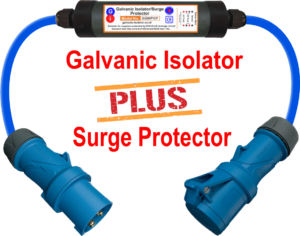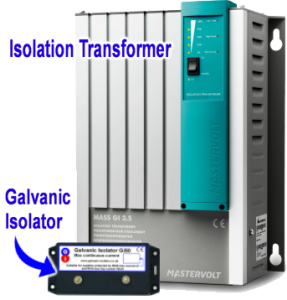Marine Galvanic Isolators vs. Isolation Transformers
Marine Galvanic Isolators vs. Isolation Transformers: A Comprehensive Comparison
Overview
When it comes to protecting your boat from corrosion and electrical faults, two popular solutions are marine galvanic isolators and isolation transformers. Both devices effectively prolong the life of your vessel’s underwater metalwork, but they operate in different ways and come with distinct advantages and disadvantages. This article will explore the differences between these two technologies, focusing on the benefits of galvanic isolators, which are often simpler and more cost-effective.
Understanding the Basics
What is a Galvanic Isolator?
A galvanic isolator is a device designed to prevent galvanic corrosion in marine environments. Galvanic corrosion occurs when two metals are submerged in water and connected by an electrical circuit, leading to the deterioration of one of the metals. Galvanic isolators work by breaking the electrical connection between the boat’s electrical system and the shore power supply, while still allowing the necessary AC power to flow through.
What is an Isolation Transformer?
An isolation transformer, on the other hand, is a device that isolates the boat’s electrical system from the shore power supply by using electromagnetic induction. It transforms the voltage from the shore power supply, whilst providing electrical isolation. This device is often used to protect against electrical shock and to filter out electrical noise, but it can be more complex and expensive than a galvanic isolator.
Key Differences
Functionality
The primary function of a galvanic isolator is to prevent galvanic corrosion, while an isolation transformer focuses on electrical isolation. Galvanic current blocking is a useful by-product, rather than the main purpose of an isolation transformer. For boat owners primarily concerned with corrosion, a galvanic isolator is often the more suitable choice.
Complexity and Installation
Galvanic isolators are generally simpler to install and require less maintenance than isolation transformers. They typically consist of electronic components that allow current to flow under certain conditions. This straightforward design makes them easier to integrate into existing electrical systems.
In contrast, isolation transformers are more complex devices that require skilled installation and may need additional components, such as circuit breakers and fuses, to ensure safe operation. This complexity can lead to higher installation costs for boat owners.
Cost
Cost is a significant factor for many boat owners. Galvanic isolators are typically more affordable than isolation transformers. A look around the internet will sho, the price of a galvanic isolator can range from under £100, while isolation transformers can cost anywhere from around £400 to over £1,500, depending on the specifications and power requirements.
Maintenance
Galvanic isolators require minimal maintenance, as they have no moving parts and are designed to last for many years. In contrast, isolation transformers may require more frequent checks and maintenance to ensure they are functioning correctly, especially if they are subjected to harsh marine conditions.
Protection
Both devices protect your boat, but they do so in different ways. Galvanic isolators are designed to protect against corrosion, whereas isolation transformers provide electrical isolation, as their primary function. Realistically speaking, for many boat owners, the primary concern is preventing corrosion, making galvanic isolators the more relevant choice.
Detailed Comparison
Installation Process
Installing a galvanic isolator is typically a straightforward process. It involves connecting the device to the shore power inlet and the boat’s electrical system. Most boat owners can perform this installation with basic tools, or even NO tools at all.
In contrast, installing an isolation transformer can be more complicated. It often requires a thorough understanding of electrical systems and may necessitate professional installation. This complexity can deter some boat owners from opting for an isolation transformer.
Performance
Galvanic isolators are designed to handle the specific needs of marine environments. They effectively block unwanted DC currents that can cause corrosion while allowing AC power to flow freely. This performance is crucial for maintaining the integrity of a boat’s underwater metal components.
Isolation transformers, while effective at providing electrical isolation, may not address the specific corrosion issues that boat owners face. They can mask certain fault conditions, such as earth leakage leading, possibly, to a false sense of security.
Size and Weight
Galvanic isolators are generally smaller and far lighter than isolation transformers, making them easier to install in tight spaces on a boat. This compact design is particularly advantageous for smaller vessels where space is at a premium.
Isolation transformers, due to their larger size and weight, may require more significant planning and modifications to the boat’s electrical system and layout, as the weight may affect the boat’s trim or even handling. This can be a considerable drawback for boat owners looking for a simple and efficient solution.
Summary
 In summary, both marine galvanic isolators and isolation transformers serve important roles in protecting a boat’s electrical system. However, for most boat owners, galvanic isolators offer a more straightforward, cost-effective, and efficient solution to the problem of galvanic corrosion. Their simplicity in installation, low maintenance requirements, and affordability make them an attractive choice for those looking to safeguard their vessels.
In summary, both marine galvanic isolators and isolation transformers serve important roles in protecting a boat’s electrical system. However, for most boat owners, galvanic isolators offer a more straightforward, cost-effective, and efficient solution to the problem of galvanic corrosion. Their simplicity in installation, low maintenance requirements, and affordability make them an attractive choice for those looking to safeguard their vessels.
While isolation transformers may provide benefits such as electrical isolation n, they come with increased complexity, higher costs, and more maintenance requirements. For many boat owners, especially those who prioritise corrosion prevention, the advantages of galvanic isolators far outweigh those of isolation transformers.
Final Thoughts
When deciding between a galvanic isolator and an isolation transformer, it’s essential to consider your specific needs and the environment in which your boat operates. If your primary concern is preventing galvanic corrosion, a galvanic isolator is likely the best choice. It offers a reliable, cost-effective solution that is easy to install and maintain.
On the other hand, if you are looking for comprehensive electrical isolation and are willing to invest in a more complex and expensive system, an isolation transformer may be worth considering. However, for the majority of boat owners, the simplicity and effectiveness of a galvanic isolator make it the preferred option.
References
For more information on galvanic isolators and their benefits, you can look <HERE>. This page provides valuable insights into the functionality, installation, and advantages of galvanic isolators, helping you make an informed decision for your marine electrical system.
In conclusion, whether you choose a galvanic isolator or an isolation transformer, understanding the differences and benefits of each device will empower you to protect your boat effectively. However, for those seeking a straightforward, economical solution to combat corrosion, galvanic isolators stand out as the clear winner.



